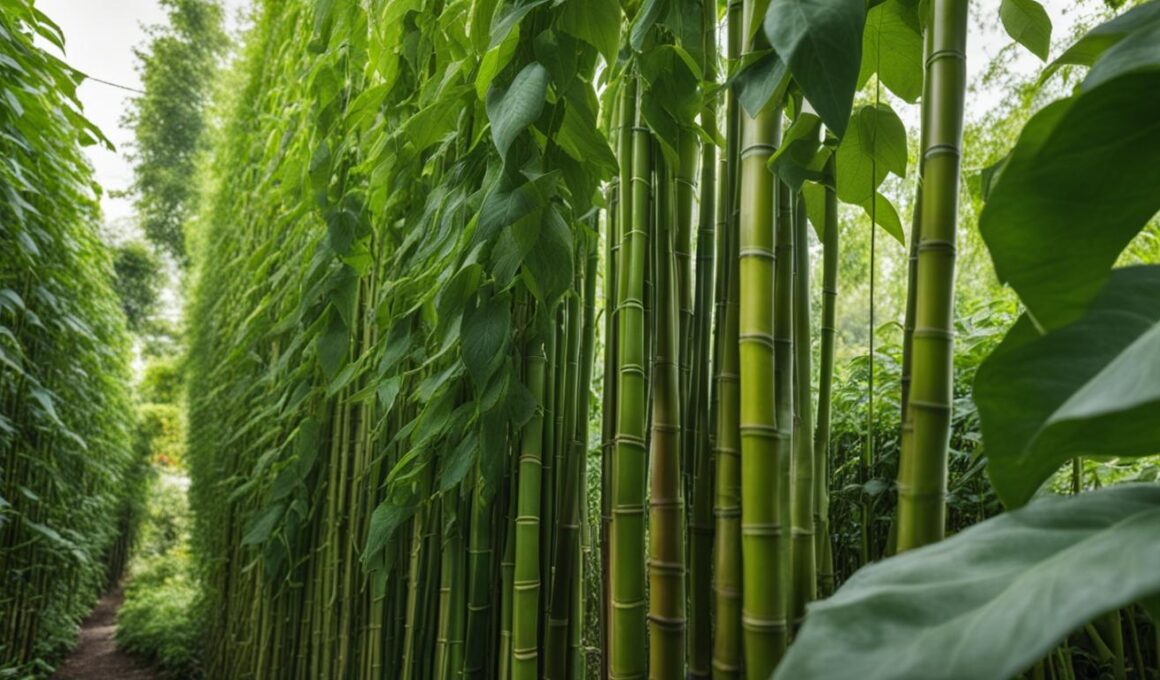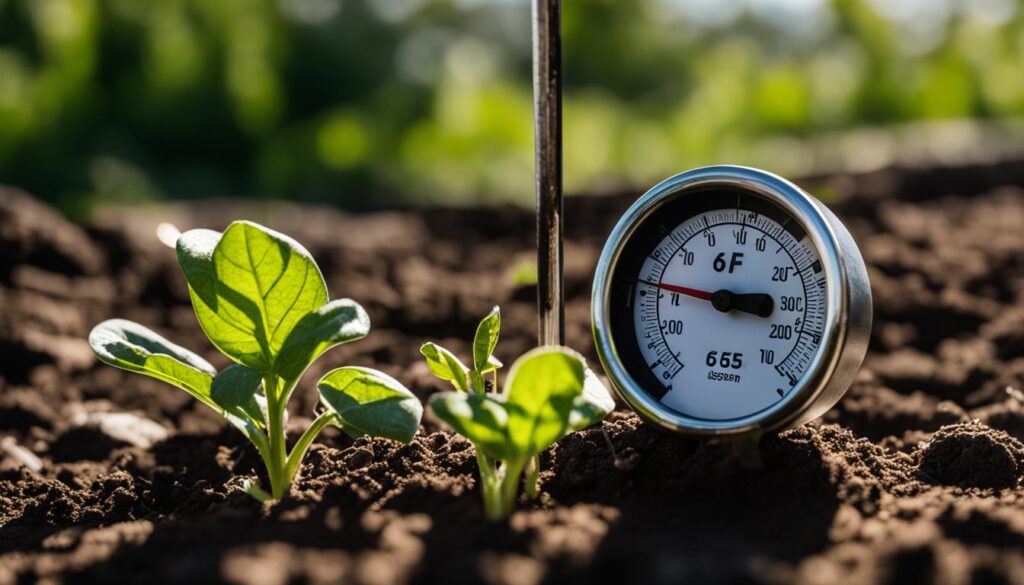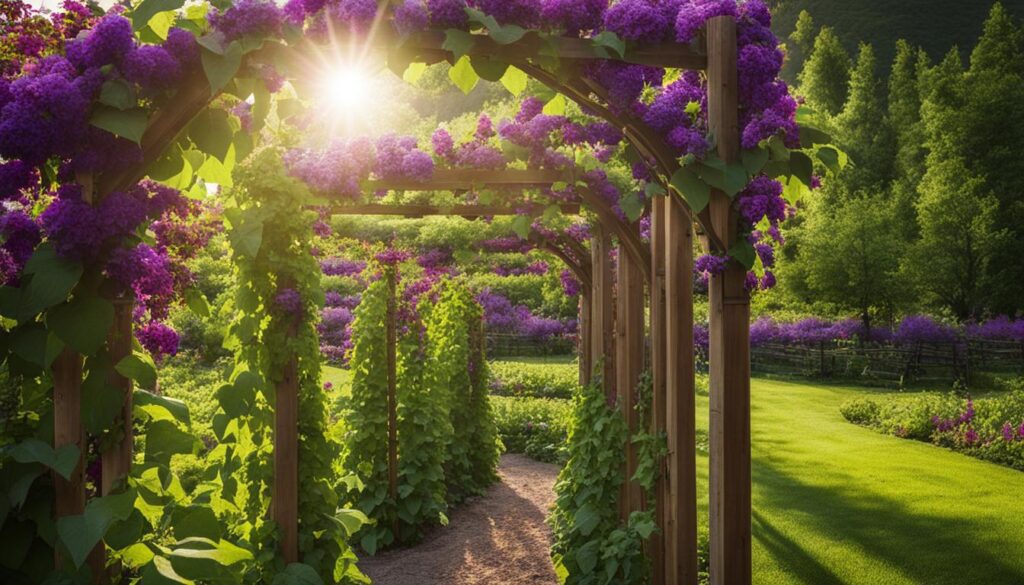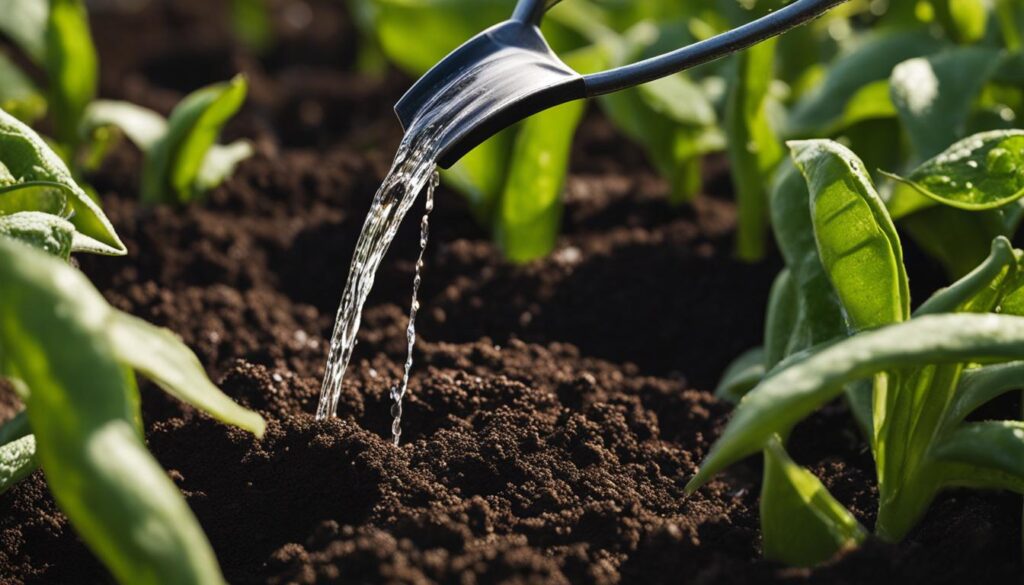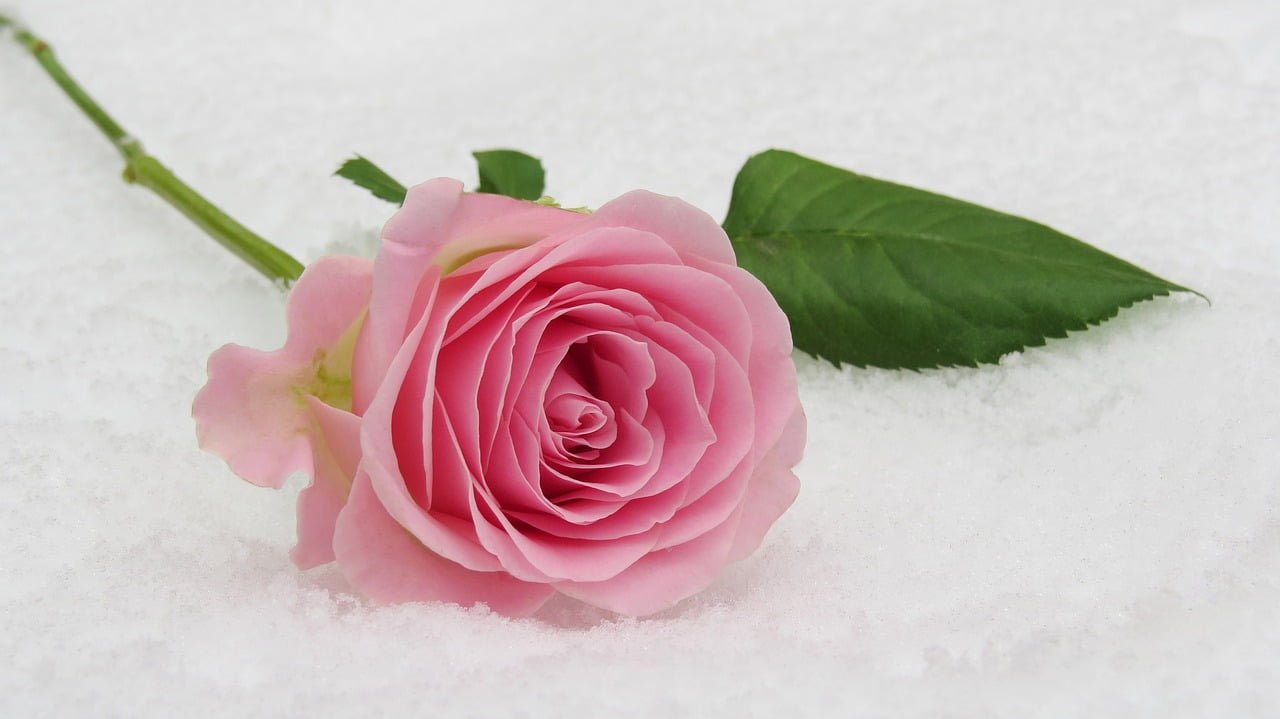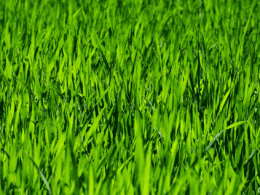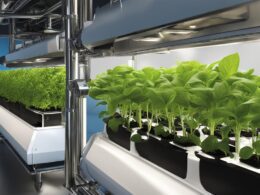If you’re looking to maximize your vegetable gardening space while enjoying a continuous and bountiful harvest, growing pole beans should be at the top of your list. These versatile vining plants are an excellent addition to any backyard garden and offer multiple harvests due to their vertical growth habit. To guarantee a successful yield, it’s essential to understand the fundamentals of planting, caring for, and harvesting pole beans, all of which begin with choosing the right type of bean trellis and optimal garden location.
Key Takeaways
- Pole beans are an efficient way to maximize garden space with their vertical growth habit.
- These vining plants thrive in full sun and well-drained, organically-rich soil.
- A sturdy support structure, such as a bean trellis, is essential for healthy pole bean growth.
- Proper planting techniques, soil preparation, and care ensure a bountiful harvest.
- Pole beans offer several pounds of produce per plant, with regular harvesting encouraging continuous flowering and pod production.
Why Pole Beans are a Garden Favorite
Pole beans benefits make them a popular choice among gardeners. Their efficient use of vertical space enables gardeners to maximize their limited garden areas, resulting in higher yields. A single pole bean plant can produce three times the harvest compared to bush varieties. In addition to their impressive productivity, pole beans feature attractive flowering vines, which add to the aesthetic appeal of any garden.
Gardeners can choose from various bean varieties, such as the Kentucky Wonder, Blue Lake, and Romano, to grow in their gardens. Each variety offers diverse flavors and textures, allowing gardeners to cater to different culinary preferences. Furthermore, the continuous harvest provided by pole beans ensures a constant supply of fresh and nourishing beans throughout the season.
- Garden space maximization: Given their vertical growth habit, pole beans utilize space efficiently, making them ideal for small gardens or limited outdoor space.
- Continuous harvest: As the beans mature at different rates, gardeners can enjoy an extended harvest period when growing pole beans.
- Attractive appearance: The vibrant flowering vines of pole beans add visual interest to gardens, enhancing the overall appearance and diversity of plant life.
- Diverse bean varieties: With several varieties available, gardeners can experiment with new flavors and textures, keeping their meals fresh and exciting.
| Bean Variety | Pod Texture | Flavor | Growth Habit |
|---|---|---|---|
| Kentucky Wonder | Firm | Distinct, hearty | Climbing |
| Blue Lake | Tender | Sweet, mild | Climbing |
| Romano | Meaty, wide | Rich, robust | Climbing |
In summary, pole beans are a garden favorite due to their ability to maximize garden space, provide continuous harvests, and add visual appeal with their attractive vines. Gardeners can also enjoy diverse flavors and textures by planting various bean varieties. With their numerous benefits, pole beans are undoubtedly an excellent choice for gardeners seeking to enrich their vegetable gardening experience.
Choosing the Right Time and Place for Planting
Considering the soil temperature and climate, as well as selecting the optimal garden location, are essential factors to ensure a successful pole bean harvest. By understanding these crucial aspects, you can provide the right environment for your beans to thrive.
Understanding Soil Temperature and Environment
Pole beans require soil temperatures to be around 60 degrees F, with ambient air at or above the same temperature, to ensure proper germination and avoid transplanting issues. It is important to keep monitoring soil temperature as it helps in creating a favorable condition for sowing seeds directly into the garden. To perform optimally, pole beans need a full sun environment with at least 60 degrees F temperatures.
| Optimal Soil Temperature | Ambient Air Temperature |
|---|---|
| 60 degrees F | At least 60 degrees F |
Selecting the Optimal Garden Location for Sunlight
Successful growth of pole beans depends on selecting a location that receives 6 to 8 hours of full sunlight every day. Keep in mind that the nutritious nature of pole beans also contributes positively to soil health, as they fix nitrogen levels, improving the ground for future crops. To ensure the best growth conditions for your pole beans, follow these planting tips:
- Choose a spot in your garden that has full sun exposure for at least 6 to 8 hours daily.
- Make sure the soil temperature is around 60 degrees F or higher before sowing seeds directly into the ground.
- Pay attention to your local climate considerations and adjust your planting time accordingly.
In conclusion, having the right soil temperature, sunlight exposure, and garden location are crucial factors in the successful cultivation of pole beans. By being mindful of these conditions, you can enjoy a bountiful harvest from these versatile and productive plants.
Planting Techniques for Thriving Pole Beans
Successful planting techniques are essential for achieving lush vines and plentiful harvests of pole beans. By following proven practices and understanding the differences between row planting and hill planting techniques, your garden will flourish with healthy and bountiful pole bean plants.
Row Planting:
For row planting, begin by sowing pole bean seeds 4 to 8 inches apart in rows 24 to 36 inches apart. This method is ideal for gardeners with larger garden spaces and allows for easy access to each plant for maintenance and harvesting.
Hill Planting:
Hill planting involves grouping seeds in small mounds or hills, typically with 4 to 6 seeds spaced evenly around each mound. This method is well-suited for gardeners with limited space, irregular growing areas, or slopes.
Regardless of the chosen planting technique, be sure to plant seeds 1 inch deep and thin the seedlings to about 4 inches apart after germination. Germination usually occurs within 7 to 10 days in warm soil. Avoid soaking seeds prior to planting, as this can hinder germination and lead to seed decay.
Germination Tips for Pole Bean Seeds
- Ensure the soil temperature is at least 60 degrees Fahrenheit for optimal germination conditions.
- Plant seeds in full sun exposure, with a minimum of 6 to 8 hours of direct sunlight daily.
- Maintain regular and adequate moisture levels throughout the germination period, avoiding waterlogged or overly dry conditions.
- Protect young seedlings from strong winds, extreme weather fluctuations, and pests with appropriate barriers or remedies as needed.
By adhering to these planting techniques and germination tips, your pole beans will be well on their way to providing you with an abundant and flavorful harvest throughout the growing season.
The Essentials of Pole Bean Supports
Pole beans require sturdy support structures to accommodate their vertical growth and ensure optimal yields. Choosing the right type of support will not only make your garden more visually appealing but also facilitate harvesting and protect your beans from soil-borne diseases. In this section, we’ll explore different pole bean trellis options and highlight the importance of installing these garden supports before planting.
Types of Structures for Pole Bean Growth
There is a wide range of climbing structures available to suit your garden style and space constraints. Here are some popular options:
- Wooden stakes or bamboo poles: Simple and budget-friendly, these supports can be installed in rows or as a tripod configuration. Secure the poles with twine or wire for added stability.
- Rope or string netting: This lightweight option can be easily attached to existing structures, such as fences, pergolas, or posts. Make sure the netting has a grid pattern, as pole beans tend to climb using a spiral motion.
- Tripod or totem pole trellises: Made from bamboo, tree limbs, or lumber, these trellises provide a strong and attractive support suitable for larger gardens or container plantings.
- Innovative supports: Roving tendrils or cages can also encourage vertical growth and natural branching, adding visual interest to your garden.
Installing Supports Before Planting
It is crucial to set up your pole bean trellis or other support structure before sowing the seeds. Attempting to install supports after planting can damage the delicate roots and hinder the development of your beans. Keep these tips in mind when preparing your garden for pole beans:
- Choose a garden support that matches your space and aesthetic preferences, considering factors such as height, stability, and ease of installation.
- Ensure the support structure is securely anchored to the ground or attached to an existing framework, such as a fence or pergola.
- Space your supports according to the specific pole bean variety you are planting, bearing in mind that some types may have more vigorous growth patterns than others.
Giving your pole beans a strong, well-placed support system from the start will promote healthier plants, simplify harvesting, and contribute to a more bountiful yield. Select from the various climbing structures available to create a functional and attractive addition to your garden.
Soil Preparation and Nutrient Management
Optimal soil preparation and nutrient management are crucial elements in the successful growth and production of pole beans. The right balance of nutrients and organic matter ensures strong plant development and bountiful harvests.
Soil amendment is an essential aspect of pole bean cultivation. These plants thrive in well-drained soil, enriched with organic matter such as compost, manure, or leaf mold. These ingredients improve the soil structure and fertility while promoting beneficial microbial activity. For garden beds, mix compost into the topsoil before planting to provide a nutrient-rich environment for the beans to grow and develop.
Although pole beans naturally enrich the soil with nitrogen, additional fertilizer for pole beans may be necessary, especially for container-grown beans. Feeding pole beans throughout the growing season ensures consistent nutrient levels, promoting vigorous growth and increased yields. Choose a balanced, slow-release fertilizer, and follow the manufacturer’s recommended application rates and instructions.
Guidelines for Nutrient Management
- Test your soil to determine its nutrient levels, pH balance, and any deficiencies or excesses that need addressing.
- Incorporate organic matter into the soil before planting, focusing on improving soil structure and fertility.
- Apply slow-release, balanced fertilizer according to the manufacturer’s recommendations and adjust as needed throughout the growing season.
- Monitor plant growth and performance to assess nutrient availability and effectiveness of fertilization practices.
- Address any observed nutrient deficiencies with additional fertilization as necessary.
Choosing the Right Fertilizer for Your Pole Beans
As you select your fertilizer for pole beans, consider the following factors to ensure the best outcome for your plants:
- Type: Use balanced, slow-release fertilizers that provide consistent nutrient supply over time and reduce the risk of nutrient leaching.
- Nutrient ratio: Choose a fertilizer with equal proportions of nitrogen (N), phosphorus (P), and potassium (K) (e.g., a 10-10-10 or 14-14-14 fertilizer).
- Organic vs. synthetic: Opt for organic fertilizers if you prefer natural ingredients and a slower nutrient release, while synthetic fertilizers generally offer quicker results.
- Form: Granular, liquid, and slow-release fertilizer forms are available, each with its own set of advantages and application methods.
By adequately amending the soil, ensuring appropriate nutrient management, and using the right fertilizer for pole beans, you’ll create a conducive environment for growing healthy, productive plants. This approach will ultimately lead to a lush and bountiful pole bean harvest in your garden.
Watering and Caring for Your Growing Pole Beans
Proper hydration is critical for pole beans, requiring at least an inch of water per week and consistent monitoring to avoid both drying out and waterlogging. In this section, we will explore how to effectively water pole beans and implement mulching and weed control strategies to help your plants thrive.
How to Water Pole Beans Effectively
Watering pole beans effectively is essential for maintaining moisture and promoting healthy growth. Here are some garden watering tips to ensure your pole beans receive the right amount of water:
- Water the plants in the early morning or late evening to minimize water evaporation.
- Focus on watering the root zone of the plant rather than the foliage to prevent diseases caused by wet leaves.
- Use a soaker hose or drip irrigation system for efficient deep watering that targets the roots without soaking the leaves.
- Check soil moisture by sticking a finger 1-2 inches into the ground; if it feels dry, it’s time to water.
For container planting, self-watering containers are advantageous to maintain consistent moisture levels due to the high transpiration rates of pole beans.
Mulching and Weed Control Strategies
Maintaining a healthy pole bean garden includes managing weeds and conserving soil moisture through mulching. Using straw or similar materials as a mulch has several benefits:
- Mulching helps prevent weed growth by blocking sunlight, making it difficult for weeds to establish and spread.
- Organic mulches such as straw can improve soil structure and nutrient content as they decompose over time.
- A layer of mulch helps prevent soil erosion and maintain an optimal moisture balance around the base of the pole bean plants, ensuring they have access to the necessary nutrients.
- Mulching can also regulate soil temperature, keeping it cooler during hot summer months and warmer during colder periods.
Implementing these watering and care strategies will help your pole beans grow strong and produce an abundant harvest.
Harvesting and Storing Your Pole Bean Crops
Reaping the benefits of your hard work in the garden is a rewarding experience, and understanding the optimal bean harvest time is key to enjoying the best possible yields. In this section, we will delve into identifying the ideal time for picking pole beans, as well as offer some helpful tips for storing and preserving these delicious vegetables.
Identifying the Perfect Time to Harvest
The optimal harvest period for your pole beans is a critical aspect of ensuring a bountiful and delicious yield. Beans should be picked when the pods have a full, swollen appearance but before the seeds inside begin to bulge. This signals over-maturity and can lead to tougher, less flavorful beans. By harvesting at the correct time, you can enjoy tender and delicious pole beans.
Regular picking helps stimulate further flowering and production, allowing you to enjoy multiple harvests from your pole bean vines. Typically, you can expect to harvest every three to five days, depending on the specific variety and growing conditions.
Tips on Storing and Preserving Pole Beans
Although pole beans are at their best when consumed fresh, there are ways to effectively store and preserve them, so you can enjoy their delightful taste well beyond the growing season.
- Blanching and Freezing: As one of the more popular methods, first blanch your pole beans in boiling water for a brief period of time and then submerge them in ice-cold water. This process helps to preserve the beans’ nutritional content, color, and texture. Afterward, pat the beans dry and store them in airtight bags or containers, placing them in the freezer for later use.
- Dehydrating: Another option is to dehydrate your beans using a food dehydrator. By removing the moisture from the pole beans, their shelf life is extended, and they can be stored in a pantry for an extended period. Just be sure to rehydrate them before use by soaking them in water.
- Canning: Preserve your beans through canning, which involves placing blanched beans in jars and processing them in a pressure canner. This method can be a bit more challenging, but it allows you to enjoy your pole beans without the need for refrigeration.
By consistently picking pole beans during the proper harvest period, you can enjoy a sustained yield from your garden plants. Furthermore, using effective storage and preservation techniques will ensure you can savor the delightful taste of pole beans all year long.
Can Companion Planting Techniques Improve the Growth of Pole Beans as Well?
Companion planting techniques can indeed improve the growth of pole beans. Choosing the right companion plants for bush beans, such as carrots, corn, or radishes, can help deter pests, provide support, and improve soil quality. This symbiotic relationship can ultimately optimize the growth of pole beans in your garden.
Conclusion
Growing pole beans is a rewarding endeavor that brings fresh, nutritious produce to your vegetable garden. With the right pole bean growing tips, you can enjoy a lush and productive harvest throughout the summer months. By carefully considering the timing, location, planting techniques, support structures, and soil preparation, you can set the stage for a flourishing crop of beans.
Proper care, including watering, mulching, and weed management, ensures that your plants thrive and produce high-quality beans. Regular harvesting, on the other hand, promotes continuous flowering and production while also providing a steady supply of tender beans for your table.
Vegetable gardening success is within your grasp when you incorporate sustainable gardening practices to create an eco-friendly, bountiful garden. Embrace the joys of growing pole beans, and delight in the delicious outcomes of your efforts.





